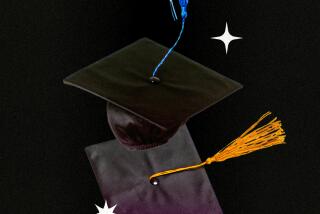They Really Work for Their Degrees : Pan American Has No Song, Just Industrious Students
- Share via
EDINBURG, Tex. — Sprawling Pan American University in Hidalgo County is dotted with modern buildings embracing courtyards and patios. In many ways, the 200-acre campus resembles others across the country.
But Pan Am, as it is known in this city of 25,000, doesn’t have a school song, a football team or rows of fraternity and sorority houses.
That’s because the hard-working, serious-minded students don’t have much time for socializing, according to Judy Vinson, 41, dean of students for the past 11 years.
Many of Pan American’s students, the sons and daughters of migrant workers, probably could not afford to go to school outside the area, she said.
“These young people have to stay here and help put food on their family tables. Ninety percent of our students work while going to school--on-campus, off-campus at fast-food restaurants, department stores, clothing stores, gasoline stations--nearly all at minimum wages. Most college students don’t have to do that.”
Any high school graduate is eligible for enrollment. Located 15 miles from the Mexican border, Pan American has the highest percentage and largest enrollment of Mexican-Americans of any university in the nation. Of the 10,500 students in this state university, 80% are Latino. Hildalgo County’s population is 85% Mexican-American.
Although all classes are taught in English, Spanish is the common language outside the classroom. Many students are provided with remedial and tutorial help, said Tom Segel, 56, executive director of the school’s alumni association.
“We give every young person a shot at the brass ring,” he said. “It is a place where miracles happen, where children of families living in humble adobe homes come to learn and go on to achieve success never dreamed possible by their parents.”
Founded in 1927 as Edinburg Junior College, the school became Pan American University in 1971. Today, it is the largest university in southern Texas, offering a bachelor’s degree program in 38 fields and master’s degrees in 17.
About 90% of the students live at home, and because many work full-time, it can take five or six years to graduate.
Arnold Trejo, 30, director of financial aid, said two-thirds of the students receive federal loans and grants. “We are proud to say this school has one of the lowest default records on student loans in the nation: 94% of our students are paying their loans on time. They feel they have an obligation to pay.”
Tuition, books and fees are $350 per semester. Room and board for the 300 students who live on campus is $1,040 a semester. About 96% of the students live within easy driving distance of the campus. About 400 students come from Mexico.
“Migrant workers leave their homes here and follow the crops several months of the year throughout the Midwest and West,” said Miguel Nevarez, 51, the university’s president for the past seven years.
“The migrant workers of Texas’ Rio Grande Valley know this school. They know it is the key to getting their children into the mainstream of American life. (Some have been) graduated from Pan Am and gone on to become doctors, lawyers, educators, business and political leaders.”
Nevarez noted that the 500,000 residents of Rio Grande Valley have the nation’s lowest per-capita income--”even lower than Appalachia”--the highest unemployment, and lowest mean education level. “Parents of our students averaged six grades of schooling.”
Born and raised in nearby McAllen, Nevarez attended Edinburg Junior College, earned his master’s degree in education from Michigan State and his doctorate in science from New York University. His parents were both born and educated in Mexico. His father, a physician, migrated to the United States in 1943.
Like Nevarez, “The great majority of the 300-member faculty are graduates of this institution, as are the vast majority of professionals, doctors, lawyers and business leaders in the Rio Grande Valley,” said Ernest J. Baca, 53, professor of chemistry and dean of the College of Arts and Sciences.
Sophomore Martha Flores, 19, has nothing but praise for Pan Am where six of her siblings also studied. “We’re not just a number here. All the professors call us by our names. They go all out to help us. They are interested in our success as human beings.”
More to Read
Sign up for Essential California
The most important California stories and recommendations in your inbox every morning.
You may occasionally receive promotional content from the Los Angeles Times.













